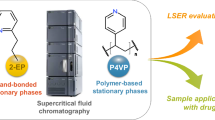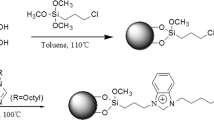Summary
By copolymerization of vinyl modified silica with acrylic acid derivatives stationary phases with imporved stability and optimum performance for the separation of basic solutes, can be prepared in a reproducible way. With a film thickness of around 1 nm the surface silanols are completely shielded but column performance is not decreased by slow mass transfer in the polymeric film. The stability of these polymer encapsulated silica based stationary phases is superior to that of conventional silanized phases in respect of column lifetime and stability at high pH values. By modification of the acrylic acid derivative cation-and anion exchanger, polar phases and chiral stationary phases of high enantioselectivity have been prepared.
Similar content being viewed by others
References
K. Karch, I. Sebestian, I. Halász, J. Chromatogr.,122, 3 (1976).
H. Engelhardt G. Ahr, Chromatographia14, 227 (1981).
H. Engelhardt, B. Dreyer, H. Schmidt, Chromatographia16, 11 (1982).
L. C. Sander, S. A. Wise, J. Chromatogr.316, 167 (1984).
K. Unger, “Porous Silica”, J. Chromatogr. Library, Vol. 16 Elsevier, Amsterdam (1979).
T. G. Woddell, D. F. Leyden, M. T. DeBello, J. Am. Chem. Soc.103, 5303 (1981).
J. J. Kirkland, J. L. Glajch, R. D. Farlee, Anal. Chem.61, 2 (1989).
H. Engelhardt, M. Czok, R. Schultz, E. Schweinheim, J. Chromatogr.458, 79 (1988).
M. Aschrif-Khorassani, L. T. Taylor, R. A. Henry, Anal. Chem.60, 1529 (1988).
G. Schomburg, A. Decke, J. Köhler, U. Bien-Vogelsang, J. Chromatogr.282, 27 (1983).
G. Schomburg, J. Köhler, H. Figge, A. Deege, Chromatographia18, 265 (1984).
B. B. Wheals, J. Chromatogr.107, 402 (1975).
I. Sebestian, I. Halász, Adv. Chromatogr.14, 75 (1976).
H. Engelhardt, M. Jungheim, Lecture at 9th Symposium on Column Liquid Chromatography, San Francisco (1986).
H. Löw, H. Engelhardt, Anal. Chem.330, 396 (1988).
I. Halász, K. Martin, Angew. Chem.90, 954 (1978).
W. Werner, I. Halász, J. Chromatogr. Sci.18, 277 (1980).
T. Daltrup, B. Kardel Chromatographia18, 81 (1984).
M. T. Hearn, Advanc. Chromatogr.20, 1 (1982).
H. Engelhardt, H. Müller, Chromatographia19, 77 (1984).
G. Blaschke, J. Liq. Chromatogr.9, 341 (1986).
Author information
Authors and Affiliations
Rights and permissions
About this article
Cite this article
Engelhardt, H., Löw, H., Eberhardt, W. et al. Polymer encapsulated staionary phases: Advantages, properties and selectivities. Chromatographia 27, 535–543 (1989). https://doi.org/10.1007/BF02258974
Received:
Accepted:
Issue Date:
DOI: https://doi.org/10.1007/BF02258974




